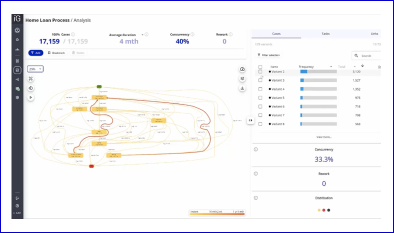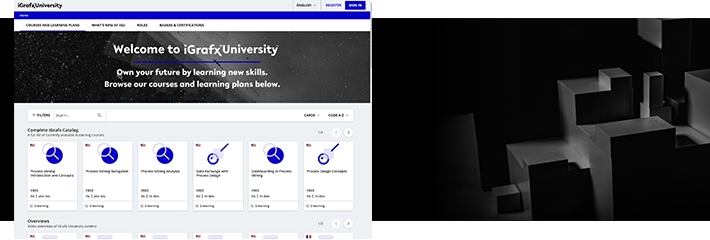“We don’t want to provide a great user experience, we want to provide the best user experience.”
That’s a quote from Alexandre Wentzo, our CEO. It’s a bold statement, but the team’s all in on making it reality. It’s at the heart of our own continuous improvement journey, at a company that delivers continuous improvement software.
Our ambition to be the most user-friendly process platform in the market is more than a goal; it’s a commitment to excellence. Our understanding of the workplace landscape has revealed a universal truth: the intelligence of a solution is only as valuable as its accessibility to the people who use it. This is why we have undertaken this major evolution in our platform to ensure that any employee, regardless of their technical expertise, can leverage the intelligence provided by our solution with ease.
Why is user-friendliness so critical? The answer is twofold. First, it directly impacts the effectiveness of the employee. A platform that can be navigated intuitively does not only minimize the learning curve but also eliminates the unnecessary friction that often accompanies complex systems. It means employees can focus on what truly matters—their work, creativity, and decision-making—rather than on deciphering how to operate the tool at their disposal.
Second, the user experience is not just a part of our product; it is the very fabric that determines the success of our clients. A positive user experience translates into higher adoption rates, more consistent data input, and, ultimately, a more reliable output of intelligence. Our clients are able to see a clearer picture of their processes, identify areas for improvement, and make informed decisions faster.
The ripple effect of this is profound. When employees feel empowered by the tools they use, their job satisfaction increases, which in turn boosts productivity and retention. For our clients, this is pivotal in creating a competitive edge in an ever-evolving market.
In essence, the journey towards being the most user-friendly platform is synonymous with empowering businesses to realize their full potential. By placing the user experience at the core of our innovation, we ensure that our clients are equipped with not just a tool, but a solution that feels like a natural extension of their workforce.
So how are we doing it?
”Make the common things easy, and the hard things possible”
You may have heard different versions of this quote said by different people, but it’s something that really stuck with me when chatting with Samuel, one of our product managers. He was talking about the essence of our strategy to deliver on the best UX. At its core, he was driving at great UX feeling great, making doing your job…fun.
Bringing difficult things within reach inherently means extending the ability of experts, but also affording non-typical users the ability to do things they didn’t know they could. It allows them to have that sense of accomplishment, that sense of fun.
We’ll get into the meat of what we’re doing next, but first, a big “thank you!” is in order, to you our loyal customers and partners that have provided us the necessary feedback to deliver on our ambition. The notes about something not being as simple as it should be, the button you wish you had, the feature that would push you over the edge to having the perfect workday. It all adds up. We hear you, and we’re all in on driving value for you.
So what are we actually doing…and when?
Soon. Our aspiration isn’t some lofty 5-year corporate goal. We’ll be releasing UX-focused features and improvements over the next couple of months. At the same time, we’re cooking up a reimagined user experience through a series of new user interfaces slated for next year. We’re talking about an order of magnitude change across the board.
We have innumerable customer interviews scheduled to further understand your viewpoint on how we can improve. And after months of searching for the right partner, we’ve hired a 3rd party agency to audit our experience in excruciating detail and help deliver the new iGrafx.
Some of these needle-moving changes we’ve started working on already, some we won’t know until the research is complete. Either way, I can promise you’ll be hearing about the new UX on a keynote stage near you at one of our events in 2024.
Back to those short-term improvements I was mentioning. Over the next couple of months, we’re focused on:
Making content creation easier
- Streamlining the process of contextualizing your diagrams with your business architecture model regardless of if you diagram first or model first. We’ll automate model creation while you diagram based on the context we have, saving you time and increasing accuracy.
- Updating our tool drawers for diagramming to have help text, come with only the most important options by default for clarity, and be fully customizable to suit your specific needs.
- Already have a diagram that you made in Visio, LucidChart, or other diagramming tool? We’re adding some “magic” to help migrate those diagrams into iGrafx even if they don’t follow the BPMN standard.
- Journey Maps are now easier than ever to build with a new standardized shape library.
Simplifying common, repetitive tasks
- I’m assuming you’ve built a slide in PowerPoint or Google Slides and experienced how easy it is to align shapes and text. We’re bringing that to our diagrams. As you’re dragging shapes and text around, you’ll get that same snap-to alignment feel. This is useful across the board, but the creators of journey maps will find it especially useful because of the typical column structure.
- Have a person (maybe a process owner) leave your organization and now you need to update all of your diagrams with their replacement? Now you’ll be able to. Enjoy the ability to bulk update and rename resources and have the change apply everywhere automatically.
- There are a ton of other quality of life improvements coming your way. Think fewer clicks, less confusion, less clutter. Things right where you expect them to be.
Adapting our software better to your mental model, not the other way around
- We’ve heard you loud and clear on this next one. Your processes will have a Process Owner field to define the person to contact about the process or model. And you can report on them, to see all of the processes they own. Don’t worry, we’re keeping the RACI assignments as well.
- Speaking of RACI, we’re aligning our cycle management to the RACI roles. Review cycle? That involves the responsible person. Approval cycle? Yes, that’s the accountable person. Same for consulted and informed. We’ll automatically add these people to the cycle group when you create their respective cycle. In a second phase, we’ll make it easier to bulk schedule cycles and report on their progress (Imagine you need each accountable person to approve their process as part of an audit).
We started with a quote. Let’s end with one from a person you might have heard of… Mahatma Gandhi:
“Be the change you want to see in the world”
Did we miss something? Have a great idea? Want to co-innovate with us? Reach out to your account rep and we’ll get you connected with the product & engineering team.
We also have a 5 question UX survey so you can let us know how we’re doing as we roll out these changes.
Here’s to making the common things easy and the hard things possible.




